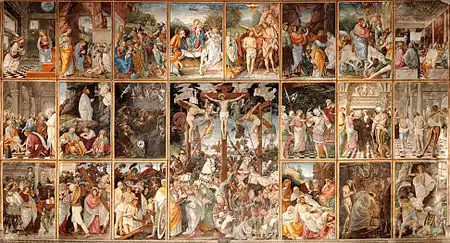Humiliation of Christ
The Humiliation of Christ is a Protestant Christian doctrine that consists of the rejection and suffering that Jesus received and accepted, according to Christian belief. Within it are included his incarnation, suffering, death, burial, and sometimes descent into hell.[1]

| Events in the |
| Life of Jesus according to the canonical gospels |
|---|
 |
|
Portals: |
State of humiliation
Calvinist theology draws a distinction between Christ's "state of humiliation", which consisted of his suffering and death, and his "state of exaltation", which consisted of his resurrection, ascension, and heavenly session. According to the Westminster Shorter Catechism, Christ’s humiliation "consisted in his being born, and that in a low condition, made under the law, undergoing the miseries of this life, the wrath of God, and the cursed death of the cross; in being buried, and continuing under the power of death for a time."[2]
The distinction between the states of humiliation and exaltation does present difficulties in explaining the idea that Christ won a victory on the cross. Peter Leithart notes that while the cross and resurrection are often thought of as a "U-shaped series of events", John's gospel, with its emphasis on the cross as the being the glorification of Christ (John 12:23), "pictures the death, resurrection, and ascension as points along a straight line, with a steep positive slope. The cross is not stairway that leads down, but the first step of a stairway whose head reaches into the heavens."[3]
Biblical basis
| Part of a series on |
 |
|
The belief of this comes from several places in the Bible. One passage says
He was despised and rejected by men;
a man of sorrows, and acquainted with grief;
and as one from whom men hide their faces
he was despised, and we esteemed him not.
Christians interpret this as referring to the later coming of Jesus.[4]
The Epistle to the Philippians in the Christian New Testament reads:
And being found in human form, he humbled himself by becoming obedient to the point of death, even death on a cross.
(See kenosis.)
Examples of humiliation
- Christ was put to shame at his birth. The Christian belief is that God could do anything, so the question is asked, "Why was Christ made so lowly by being born in a stable and laid upon a manger?"[5]
- Herod sent out soldiers to kill him.[Mt 2:16] Jesus was saved from death as a mere baby by a miracle. The Christian belief is that this was God.
- Christ was rejected by his own town's synagogue. He read from Isaiah and the people rejected him. Jesus stated that no prophet was accepted in his own town.[6] The people were filled with wrath and tried to kill him.
- Christ was put to shame for doing miracles such as casting demons out of men.
- Jesus was rejected by his own people in favour of Barabbas, a criminal.[Mt 27:21] He was then spat upon, beaten and mocked by the Roman soldiers.[Mt 27:30]
- The ultimate form of humiliation, Christ was crucified while being mocked.
Humility
In Early Christianity, the prevalent view of Jesus was based on the Kyrios image (Greek: κύριος) as "the Lord and Master", e.g. in his Transfiguration.[7] In the 13th century a major turning point was the development of the "tender image of Jesus" as the Franciscans began to emphasize his humility from birth in a humble setting to his death on the cross. The Nativity scene promoted by Saint Francis of Assisi portrayed a softer image of Jesus.[8] The concept that the omnipotent Creator would set aside all power in order to conquer the hearts of men by love and that he would have been helplessly placed in a manger was touching to the believers as that of the sacrifice of dying on the cross in Calvary.[9]
See also
References
- Grudem, Wayne (1994). Systematic Theology. Grand Rapids: InterVarsity Press. ISBN 0-85110-652-8.
- Westminster Shorter Catechism. 1647.
- Leithart, Peter (July 1995). "When the Son Is Glorified". Biblical Horizons. 75. Retrieved 3 May 2012.
- Wiersbe, Warren W. (2002). The Bible Exposition Commentary: Old Testament: The Prophets (2nd ed.). Colorado Springs, Colo.: Chariot Victor Publishing. p. 60. ISBN 0-7814-3530-7.
- Berkhof, Louis (2007). Manual of Christian doctrine (2nd ed.). Arlington Heights: Christian Liberty Press. pp. 75–77. ISBN 1-930367-90-2.
- Cook, David C (2003). Craig A Evans (ed.). Bible Knowledge Background Commentary: Matthew-Luke. Colorado Springs: Victor Books. p. 285. ISBN 0-7814-3868-3.
- Mills, Watson E (2001). Edgar V McKnight and Roger A Bullard (ed.). Mercer Dictionary of the Bible. Macon: Mercer University Press. pp. 520–525. ISBN 0-86554-373-9.
- Brooke, Rosalind B (2006). The Image of St Francis (1st ed.). Cambridge: Cambridge University Press. pp. 183–184. ISBN 0-521-78291-0.
- George F Thomas, ed. (1944). The vitality of the Christian tradition (3rd ed.). Freeport: Books for Libraries Press. pp. 110–112. ISBN 0-8369-2378-2.